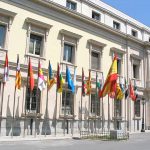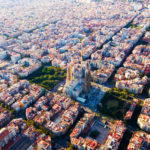Last updated on September 13th, 2019 at 09:08 am.
Most people who are wanting to explore Spain will visit its major cities of Barcelona, Madrid, Seville and Granada. Each one is special and different and provides examples of Spain’s rich past. But if you want to travel to somewhere a little different that has a wealth of history behind it then you wouldn’t go far wrong by visiting Córdoba.
The city of Córdoba lies close to the mountainous region of the Sierra and near the River Guadalquivir. The city itself is located in the province of Córdoba which also includes Priego and Lucena. The province is within the Andulician Autonomous community. It is a world-heritage site for its Mosque-Cathedral and the streets and buildings around it.
We can’t be certain just how far back in history Córdoba was used as a settlement. However, we know there was a settlement there at the time of the Bronze Age and that it became an important mining and commercial centre. The proximity to the River Guadalquivir was particularly influential in establishing links between Córdoba and the main cities of the period.
The city thrived under Roman rule and at this time a large number of important public buildings were constructed. For a period after this there was cultural and economic stagnation and then the region was settled in by Muslims. Córdoba became the administrative centre and in 756 it became the capital of the independent Emirate of Al-Andalus.
Córdoba continued to be a city of major importance at this time until the collapse of the Caliphate in 1013. A cit of mixed fortunes, it wasn’t until the mid 20th century that the economy in Córdoba picked up and it came into its own. Now a world heritage site, there seems to be evidence of a different culture around nearly every corner that you turn.
What makes Córdoba stand out is the very heritage that has also caused it so much turbulence at times. Perhaps best known and certainly most represented in photos and images of the city is the Mosque-Cathedral which, as its name suggests, is a true tribute to the way in which both religions are interlocked in Spain.
The great Mosque – Cathedral
The interior of the Mezquito of Córdoba is probably the image that most people associate with the city. It is a huge expanse of columns (856) and arches with inscriptions of the Koran in gold and rich mosaics. As you might expect, it experienced a number of extensions over the years. In the very centre of the Mezquita is a Renaissance Cathedral which led to the destruction of parts of the column hall.
The building is extraordinary as it combines relics from a wealth if different cultures including Greek-Roman, Egyptian and Visigothic. If you do travel to Córdoba you cannot leave without seeing this amazing building.
The castle of Almodóvar
Set on a hill 22km from Córdoba, the castle of Almodóvar dates back to the year 740. It is an imposing building that is worth a visit. As with many of the buildings in here, elements of both Muslim and Christian tradition can be spotted and add to its interest and beauty. As you would expect, its position means that you can enjoy some stunning views of the Guadalquivir Valley from its terraces.
Unlike other castles you might visit, this one is well-preserved following restorations carried out by the Earl of Torralva. There are guided tours around the castle if you want to find out more about it and ‘knight’s banquets’ are held on selected dates.
The historic quarter
The city centre itself is testament to the various cultures that have chosen to make Córdoba their home. A Jewish Quarter houses some of the most notable monuments. An intriguing part of the city, you can weave your way through its winding alleyways and past its whitewashed houses.
A number of Córdoba’s most celebrated buildings can be found here including the Royal Fortress, the Arabian Baths, the Bullfighting Museum, the Roman Bridge and the Zoco Municipal.
The Jews were a very important influence in Spain and particularly in Córdoba where the synagogue remains evidence of the important role the Jewish people had before their expulsion. It is only a small building but is beautifully decorated with Hebrew inscriptions.
It is ideal if you are out on foot as so many of these spectacular sights are within walking distance of one another.
The Roman remains
Evidence of some of Córdoba’s earliest settlers can be seen scattered around the city and its environs. The Templo Romano is located in the centre of Córdoba and is the remains of a temple dating back to the 1st century. The columns that remain are huge and are evidence of the importance that must have been given to this building in Roman times.
The Roman Bridge (Puente Romano) is located over the Guadalquivir river in front of the Mezquita Mosque. It was a key link and part of a commercial and military route. The statue of San Rafael is in the centre of the bridge. This homage to the patron saint of Córdoba was constructed in the 17th century.
The Roman Quarries or caves are located at the bottom of the Sierra Morena Mountains. The caves were discovered in 1929 and are a man-made warren of tunnels.
The Alcázar de los Reyes Cristianos
The Alcázar includes a castle, gardens and a bathhouse. The towers include the Tower of the Inquisition and the Homage Tower where the occupants swore oaths to protect the fortress. The royal baths are in the basement of the Alcázar and are well worth visiting.
The gardens are particularly beautiful with a wide variety of plants, trees and bushes. The paseo de los reyes includes sculptures of the monarchs and there are some stone fountains and some of the original marble floor slabs still remain.
Flowers and gardens
What perhaps defines Córdoba along with its extraordinary representation of a rich cultural mix, is the number of beautiful gardens, flowers and plants that can be found there.
The Botanical gardens includes hothouses, a rose garden and a touch-and-smell garden as well as two museums. The hot house includes more than one hundred plant species from the Canary islands.
Another major attraction includes the Callejon de la flores which, as its name suggests, is a cobbled street that drips flowers from the balconies and walls of its whitewashed houses. A real photo opportunity and picture postcard of what many imagine traditional Spain to be like.
A particularly good time to see both private and public displays of plants and flowers is during the patios festival which is traditionally held during the second and third week in May. Many residents enjoy taking part in the patio contests which bring out the best in colour and scent.
Something more active
If you would rather be engaged in something a little more energetic there are a number of sporting and recreational opportunities around Córdoba. A water park, golf course and backpacking opportunities mean that on your days off from site seeing you can enjoy the local facilities with residents too.
There are two golf courses in Córdoba; Pozoblanco Club de Golf and Club de Campo de Córdoba. If you’re willing to travel a little further there are a number of natural parks in the vicinity including Sierra de Hornachuelos Natural Park, Sierra Norte Natural Park and Sierra de Cardeña and Montoro Natural Park.
Córdoba is a surprising city that will leave you with lasting impressions of the great cultural traditions and historic legacy that makes Spain such an interesting country to explore.
No comments yet
There are no comments on this post yet.




Leave a comment